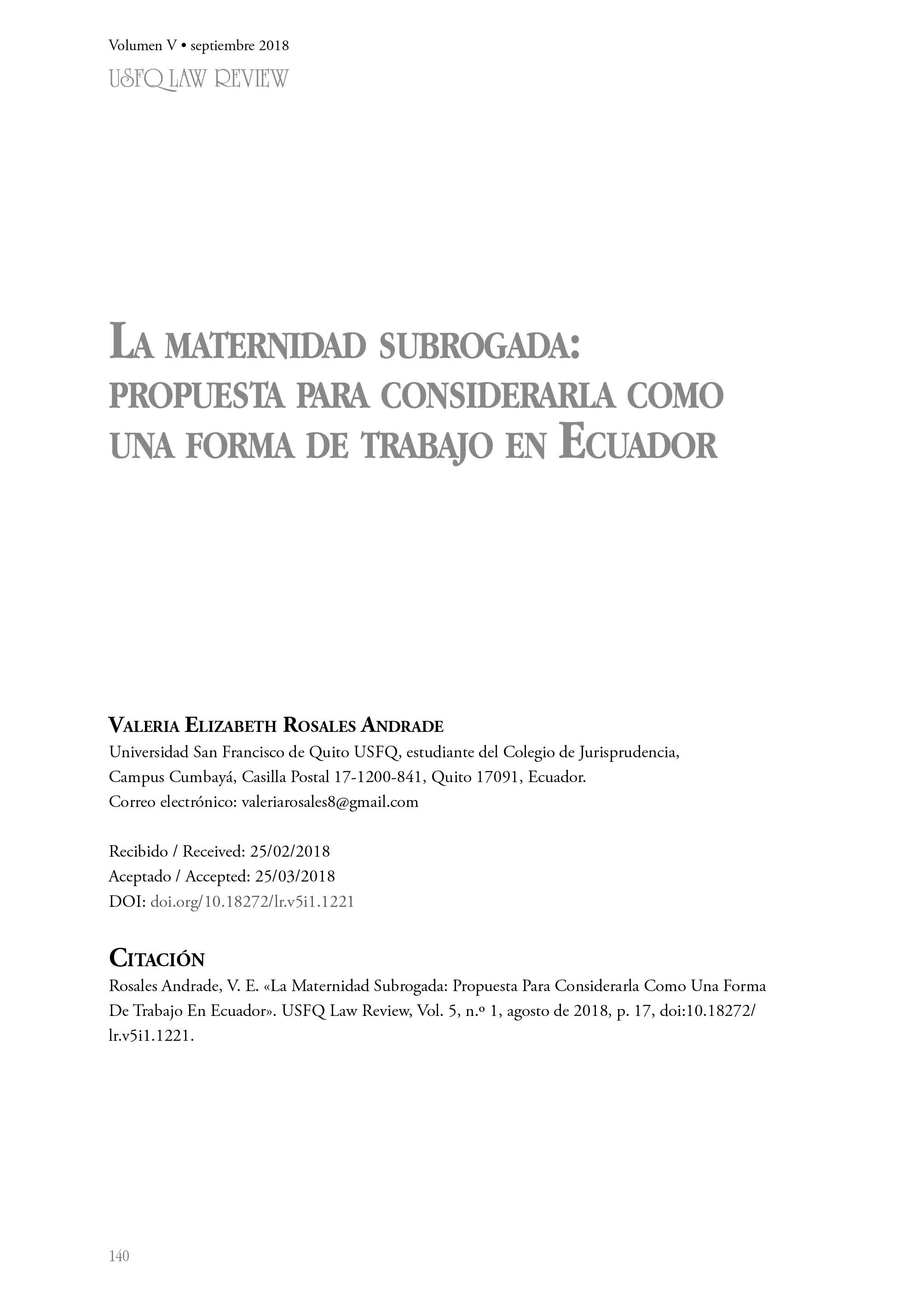Surrogate Motherhood
A Proposal to Consider It as a Form of Work in Ecuador
DOI:
https://doi.org/10.18272/lr.v5i1.1221Keywords:
Ssurrogate motherhood, surrogate mother, surrogate couple, employment relationship, dependence relationship, individual work contractAbstract
The following article is focused on the employment relationship and the rights that could be constituted between the surrogate mother and the surrogate couple, based on an analysis of the elements that the Labor Code establishes for an individual work contract to be set up. The legal problem focuses on the lack of regulation on the subject in question and the possibility of establishing the surrogate motherhood within the Labor Law and the Constitution. Its lack of regulation is particularly interesting considering that in the Ecuadorian legal system there are several norms oriented to protect certain values and rights regarding the rights of the family and the people they refer. Consequently, from these considerations will be analyzed which elements of the Constitution would allow surrogacy to be considered as a form of work and which articles of the Labor Code and the Constitution should be amended in order to include it as such.
Downloads
References
Barajas, Santiago. Derechos del trabajador asalariado. México, D.F.: PN / IIJ - UNAM, 2004
Cabanellas, Guillermo. Contrato de Trabajo. Buenos Aires: Heliasta, 1981. Tomo II.
Código de Familia de Ucrania. No. 2947-III de 10 de enero de 2002.
Código de la Familia (Federación Rusa). N 222-FZ de 25 de noviembre de 2013 (última modificación).
Código del Trabajo.Registro Oficial Suplemento 167 del 16 de diciembre de 2005.
Constitución de la República del Ecuador. Registro Oficial N. 449 del 20 de octubre de 2008.
Córdoba, Jorge & Sánchez, Julio. Fecundación humana asistida: aspectos jurídicos emergentes. Buenos Aires: Alveroni Ediciones. 2000.
Corte Suprema de California. Johnson v. Calvert. Sentencia No.023721 de 20 de mayo de 1993.
Corte Suprema de Estados Unidos. Baby M. Sentencia, 3 de febrero de 1988.
Corte Suprema de Justicia. Segunda Sala de lo Laboral y Social. Gaceta Judicial. Serie XVII. No. 1. 20 de abril de 1999.
Finkelstein, Alex et al. Surrogacy Law and Policy in the U.S.: A National Conversation Informed by Global Lawmaking. Columbia Law School Sexuality and Gender Law Clinic, 2016.
Frankford, David; Bennington, Linda y Ryan, Jane. "Womb Outsourcing: Commercial Surrogacy in India". MCN, American Journal of Maternal Child Nursing. 40/ 5 (2015).
Fundación Víctor Grífols i Lucas. Interrogantes de la Fundación Víctor Grífols y Luca: Aspectos medicobiológicos de la subrogación uterina. Barcelona: Fundación Víctor Grífols y Lucas. 2010.
Gimeno, Anna. "El deseo de ser madre". España: Alba Editorial, 2011.
Guillot, Rosa. "La maternidad portadora, sustituta, subrogada o de encargo". BFD: Boletín de la Facultad de Derecho de la UNED, núm. 7, (1994).
Indian Council of Medical Research. National Guidelines for Accreditation, Supervision & Regulation of ART Clinics in India, 2005. http://icmr.nic.in/art/art_clinics.htm (acceso: 08/04/2018).
Lanchimba, Cintya y Medina, Paúl. "Fecundidad en el Ecuador y su relación con el entorno social y evolutivo". Revista Analítika, Volumen 1 (2014)
Ley Federal "Normativa de protección de la Salud de la Federación de Rusia", de 1 de enero de 2012.
Ley Federal "Sobre los Actos de Registro Civil" (Rusia). Artículo 16. N°143, de 15 noviembre de 1997.
López, Irene. La prueba científica de la filiación, 1. México: Editorial Porrúa, 2005.
Ministerio de Justicia (Ucrania). Acto alteraciones en las regulaciones de registro civil en Ucrania. Nº 1154/5 del 22 de noviembre de 2007.
Ministerio de Salud (Ucrania). Acto en la aprobación del aparato tecnologías de reproducción. N° 771 del 23 de diciembre de 2008.
Pacheco, Víctor y García, Agustín. Criterio y recomendaciones bioéticas sobre la maternidad subrogada en Ecuador. https://www.salud.gob.ec/wp-content/uploads/2018/02/MATERNIDAD-SUBROGADA-CRITERIO-CNBS.pdf (acceso: 18/05/2018)
Ruiz, Rocío. Maternidad Subrogada: Revisión bibliográfica. Tesis de grado. Universidad de Cantabria. Santander, 2013.
Sala de lo Laboral y Social. Elementos de la Relación Laboral. Gaceta Judicial. Serie XVII, 20 de abril de 1999.
Sambrizzi, Eduardo. La procreación asistida y la manipulación del embrión humano. Buenos Aires: Abeledo-Perrot, 2001.
Santiago, Santiago. Derechos del trabajador asalariado. México, D.F.: PN / IIJ - UNAM, 2004.
Svitnev, Konstantin. "Legal regulation of assisted reproduction treatment in Russia". Reproductive biomedicine, 20.7 (2010).
Vásquez, Jorge. Introducción al Derecho Laboral Ecuatoriano: Derecho Individual.
Zegers, Fernando., et al. Registro Latinoamericano de Reproducción Asistida, 2008. http://redlara.com/images/arq/2008_registro%202008.pdf (acceso: 18/05/2018).

Published
How to Cite
Issue
Section
License
In relation to copy rights, authors publishing with USFQ Law Review know and accept its internal policies, including but not limited to:
1. Open Access Policy.
2. Authorship Policy.
3. Copyright Policy.
4. Pre-Publication Policy.
5. Post-Publication Policy.
6. Intellectual Property Protection Policy.
7. Digital Preservation Policy.

